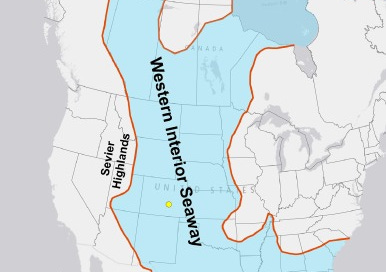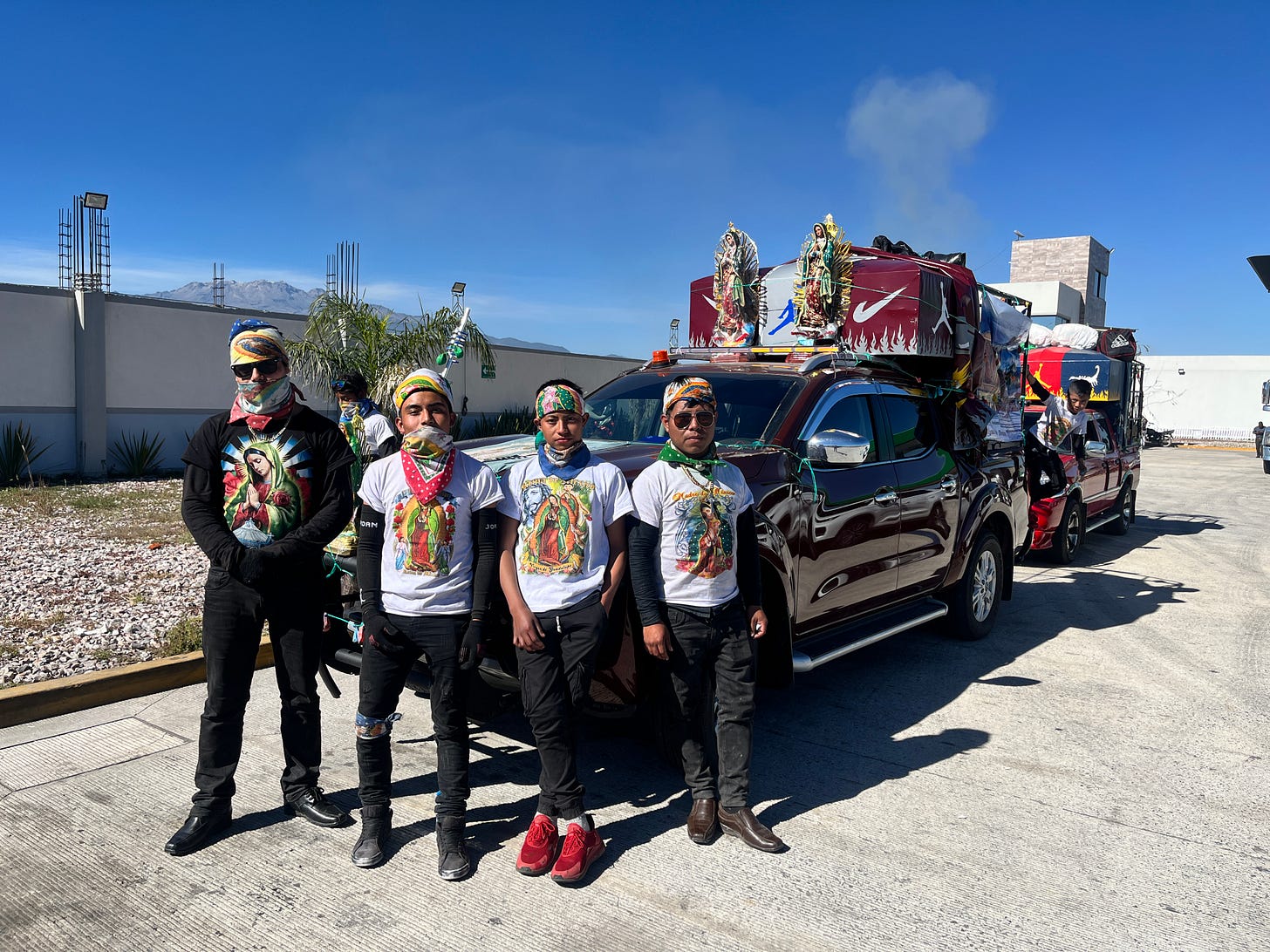The highways south of Mexico City will run you across dizzying mountains and peaks, but this territory was once the low shoreline of an island.
Larimidia is what the geologists call it, a craggy and leviathan isle that once stretched, 77 million years ago, from the high latitudes of the wintry north to where, today, you’ll find Oaxaca. I was sitting in Mexico City recently, waiting for work to come in, and so I thought, hell: let’s drive down inframundo way, let’s drive along the shore of Larimidia and see what we can see.
That shore is, today, Carretera Federal 150, a sometimes bumpy, sometimes smooth highway that takes you east and south out of the valley of Mexico. All those millions of years ago it would’ve run alongside the Western Interior Seaway, a half-mile deep water lane that covered what is now America’s plain states and Mexico’s low-lying eastern shore. Sharks and giant-jawed fish swam its warm and tropical waters, which also teemed with the plankton whose chalky secretions gave the Cretaceous its name.
Not to mention: Plesiosaurs, those colossal flippered things. The Monster of Aramberri is what they called the biggest specimen when they found it in the hills of Aramberri in Nuevo Leon. It would’ve been some 40 feet long and 50 tons fat, they say. Today a reconstruction of the beast hangs from the ceiling in the Papalote Museo del Niño, in Monterrey.
But I didn’t think I’d find any bones on the roadside of Carretera Federal 150.
As I climbed out of the DF what I saw, instead, were roadside staples of the Mexico federal highway system: roadside taqueria stands, portly tias ladling aguas frescas from plastic jugs, and stray dogs nosing around the wheels of parked rigs. In the distance, the smoke of Popocatépetl mingled with the clouds. The only evidence of the Cretaceous were potholes. Potholes the size of plesiosaurs.
But the 150 took me up and through Mexico City’s smog layer and past the volcanoes, where it then stretched out flat on towards Puebla. Out there the road is smooth and flat and the sun, which had been filtered by exhaust fumes and cement powder in the city, shined bright and hot. There was nothing to distract but green-brown pastures, scrappy wildflowers, gravel shoulders, and the occasional cinderblock hut (some collapsing, some being built) that looked, to my too-online eyes, like the grey and lazy renderings of Minecraft.
This is central Mexico, on the road, by day. Not the manicured highways of the United States (high sound barriers, tall pines in the median), or the precisely engineered flattop of Europe with their brightly painted lines, but serviceable roads winding through a patchwork of farmland and industry in varying states of neglect. But always, a few hundred yards to either side, a beautiful rise of mountains and peaks.
And then, past Puebla, as I was about to take a right down Carretera Federal 135, I noticed something out of place: a runner on the roadside, carrying a torch.
It’s hot out there on the plain, much hotter than Mexico City, but the runner was jogging along, unhurried, in black jeans and a long-sleeved tee. A bandanna around his face provided some meager protection from the exhaust of passing rigs. God he must be sweltering, I thought as I passed.
Not too much further, a pickup truck with an ornate and colorful cabin over its bed idled in the breakdown lane. In the shade of the cabin were three, no four, no five other runners, each staring intently after their friend and waving him on.
Over the years on Mexican highways I’ve seen bicyclists carrying oversized crates of vegetables, families with children walking between towns, farmers herding livestock, and more. The runners must be on some type of local race between towns, I thought, as I pulled into a roadside Pemex to get some gas.
But there, in the parking area, were more pickups with more brightly-covered cabins covered in an array of signs, from Nike swooshes to Catholic saints. Their occupants were milling about, buying water, standing in the shade, sweating, eating tacos on red plastic plates. There must have been a hundred of them, and they looked dog tired. This was much more than a local race. I parked my car, poured some water for my dog, and walked over to one of the pickups.
“Hola, que tal,” I said to one of the runners, a teenager I guessed, sitting in the covered back of one of the trucks with his elbows on his knees. He looked around at the others in his group and flashed an embarrassed smile. “Una pregunta,” I continued in Spanish, trying my best to appear a kindly and harmless gringo. “Is this a race?”
“We run for the Virgin of Guadalupe,” he said, referring to Mexico’s most popular saint, whose feast day was coming up soon on December 12th. He looked pained to be talking to me, whether from exhaustion or wariness I didn’t know.
“That’s really cool, man,” I said, trying to reassure him of my intentions. “And where are you running to?”
“We ran to the basilica,” he said, and I supposed he meant Basilica de Santa María de Guadalupe in Mexico City, one of the most popular religious sites in the world, where an estimated five million pilgrims visit during the days surrounding the Catholic holiday. I stood there in the sun, felt the heat coming off the truck, and thought of flesh-pressed crowds swarming the basilica. “Now we run back to our town,” he said. I asked him where that was.
“Near Oaxaca.”
“And you run the whole way?”
“Five hundred meters. Then rest, than another.”
“Oh, una carrera de relevos,” I said. He nodded, but furrowed his brow and smiled tightly. His fellow runners, who had been standing nearby, had walked to the front of the truck, leaving him alone to contend with me.
“Do you understand me, my Spanish,” I asked.
“Not really, a little,” he said.
I laughed and told him I was sorry for my accent, thanked him, and walked over to the mini super to get a bottle of water. Two more runners walked in, and I asked them the same. When they responded, I didn’t understand a word. I thanked them and walked to the counter to pay.
“They’re speaking Zapoteca,” said the clerk, and I realized that might’ve been why the first runner I spoke to seemed uncomfortable. We were both speaking our second language—and he’d been running all morning in the sun.
“They run from their pueblos to the basilica in Mexico City, and back,” the clerk said. “They do this for their promises to the virgin. Because there are so many people at the basilica, you know? So they do a run instead.”
Promises the Virgin are a big part of Catholic practice in Mexico, where the faithful vow to do something specific in exchange for the Virgin’s intercession in matters of health, protection, success, any number of things. To fulfill their promise, many penitents crawl on their knees to the basilica. These guys: they run.
Later, I’d learn that it takes the runners a week or sometimes more to make their pilgrimage, groups of three or seven or fifteen packing themselves into camionetas with water and snacks and cushions for a bed. It’s something that occurs all over Mexico in December, but not all run to the basilica. Some do smaller runs, from town to town. These guys just happened to live close enough. And they were that devoted.
On the way out of the Pemex I stopped to chat with another group of kids who couldn’t have been more than 18 years old. Each of them was wearing black jeans, t-shirts with images of Guadalupe, and bandanas in red, yellow, and green. Some of them weren’t wearing running shoes, but boots. They almost look like a high-wire act, I thought — traveling performers on the way to a show, the stylish and handsome Flying Mexican Wallendas.
But they were runners, too, and they had two hundred miles to go.
“Hola,” I said, rolling the window down. “You guys look amazing. Do you mind if I take a photo?”
“Hola, como estás,” one of the kids said. “Let me ask the guys.”
📕 What is Julian’s?
Julian’s is a handbook for curious travelers written by Steve Bryant, who lives and works in Mexico City. Julian’s is named for his grandfather and the wordmark is designed in Frustro, a typeface inspired by the Pemrose Triangle, and which represents impossible objects—appropriate for Mexico City, which Salvador Dali once described as more surreal than his art. Come visit us soon, we’d love to meet you.






![Life-sized restoration of the "Monster of Aramberri" in the Papalote Museo del Niño, in Monterrey.[15] Life-sized restoration of the "Monster of Aramberri" in the Papalote Museo del Niño, in Monterrey.[15]](https://substackcdn.com/image/fetch/$s_!z8H_!,w_1456,c_limit,f_auto,q_auto:good,fl_progressive:steep/https%3A%2F%2Fsubstack-post-media.s3.amazonaws.com%2Fpublic%2Fimages%2Fa3d328ec-2446-4159-a812-6851cd482535_2880x1621.jpeg)
